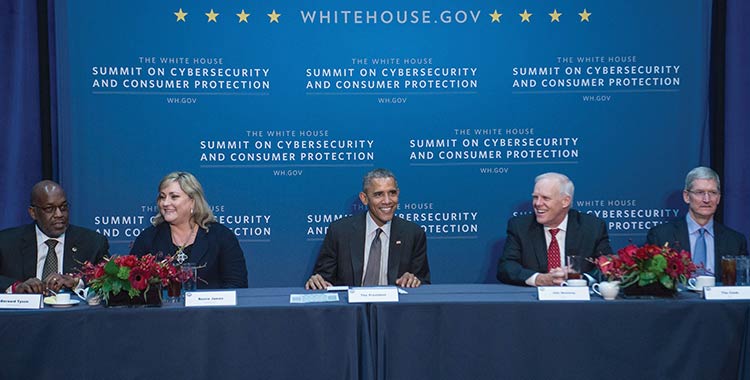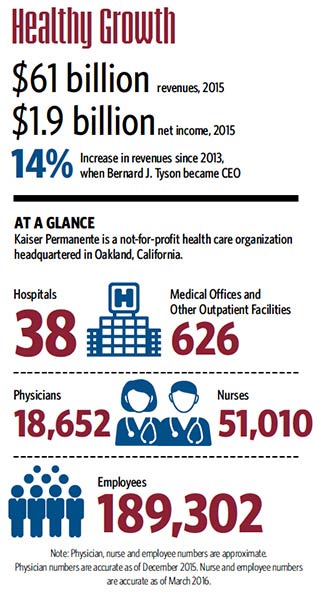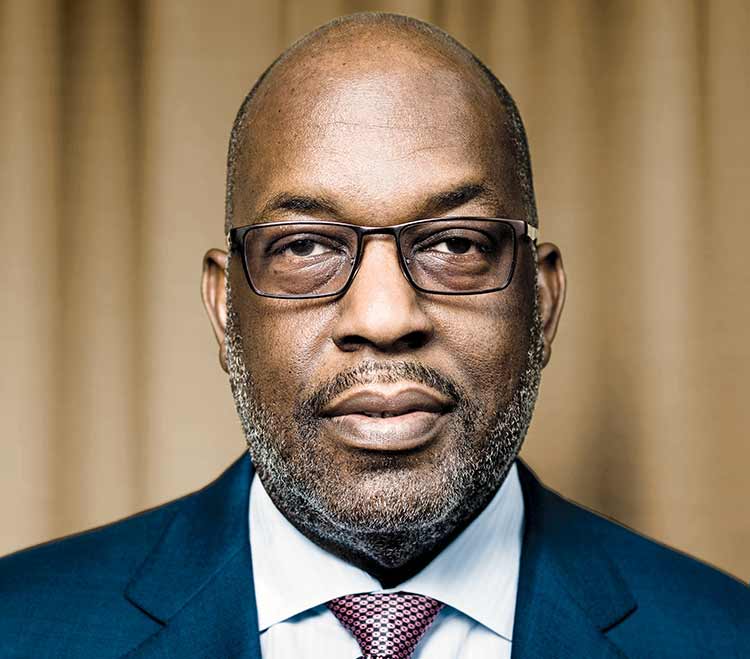How Kaiser Permanente Is Transforming Health Care
Bernard J. Tyson is not one of those CEOs who just talk about change. He embraces it. He advocates for it. He even cheers it on. Throughout his career at integrated health care provider Kaiser Permanente, Mr. Tyson has been willing to challenge business as usual—as he reimagined the organization’s brand image from sterile HMO to health and wellness partner, as he championed diversity across the workplace and as he rolled out new processes to improve efficiency and care.
Now his ability to evolve is being put to the ultimate test, leading Kaiser Permanente through unprecedented change as the U.S. health care system faces an onslaught of disruption while simultaneously trying to curb rising costs. Annual health spending in the United States, where Kaiser Permanente does all of its business, is projected to jump an average of 5.8 percent through 2025. That is 1.3 percentage points faster than growth of the gross domestic product—and would represent 20.1 percent of the total economy by 2025, according to the U.S. Department of Health and Human Services.
Mr. Tyson, along with every health care executive in the country, needs a compelling vision.
“There is a reason why you become the CEO. You have value to add,” Share on X he says. “My value-add is determining how to best position the organization to meet the needs of millions of people in the future.”
For Kaiser Permanente, that means nothing short of a revolution in traditional doctor-patient dynamic.
“The entire health care industry was built on the idea of people coming to our space for care,” he says. “Whether that’s a medical office, a hospital, or a pharmacy, we’ve designed the health system for people to come to us for their health needs. For the future, what we have to do is push care out to where the patient or member is. That’s our reimagined idea—care anywhere. What we’re trying to do now—what we will do—is turn this industry upside down.”

Affordability Above All
No matter how forward-thinking the vision, Mr. Tyson will not get very far without making cost control priority No. 1. Nearly 58 percent of U.S. consumers surveyed said rising health insurance rates add financial strain to them or their family, according to a May 2016 TransUnion survey. And three in four are extremely or somewhat concerned about increased costs from health insurers’ 2017 rate proposals.
“Affordability is the single biggest issue in the industry today,” Mr. Tyson says. “The work we have in front of us in the industry is to build a more affordable system that covers and cares for the American people.”
Kaiser Permanente’s integrated system—which includes a network of providers, hospitals and insurers—gives it a jump-start on controlling costs, Mr. Tyson says. Most of the industry works off an input model, where money flows to health care companies when patients do things like visit the doctor, take tests or buy prescription drugs. Providers in that case are incentivized to maximize those inputs so as to maximize revenue. Meanwhile, insurers, which hold the “first dollars” from their members, are incentivized to limit inputs to limit expenses.
“What we’re trying to do now—what we will do—is turn this industry upside down.”
Because Kaiser Permanente holds those “first dollars” and has a say in where they go, Mr. Tyson and his leadership team are free to do things differently. For instance, they can reward doctors and nurses, and other caregivers through year-end bonuses tied to improving clinical outcomes for patients.
“[Trying new things] is part of who we are,” he says. “It goes back to the day when [founders] Henry Kaiser and Sidney Garfield didn’t want to build this organization with the mindset of a sick care system when what people really want to do is live healthy, happy, productive lives. Today the question is, how do we build that kind of system while serving as a model for the entire health care industry by dealing with the issue of affordability?”
Mr. Tyson fires off a one-word answer: “Innovation.”
“We have an internal saying here,” he says. “We say, ‘We want to be the best at getting better.’ That calls for a disciplined approach of improvement that is continuous. It’s not about looking for a silver bullet. It’s not about looking for a big bang.”
Tech as a Tool
Much of Kaiser’s continuous improvement in health care affordability ties back to its strategic use of technology. The organization employs nearly 200,000 people, with about 6,000 in IT, and focuses each year either on tech upgrades or entirely new systems. (It spent a whopping $4 billion alone to implement “Kaiser Permanente HealthConnect,” a comprehensive health information system that gives doctors and patients access to electronic medical records.) “We have tech embedded in almost everything we do,” Mr. Tyson says. “We’re digital all the way.”
And yet he is quick to point out that his organization never integrates a technology just because it is shiny and new. Any time Mr. Tyson meets with IT staff, he also includes doctors, medical center executives and/or workers from other departments—anyone who might be affected by the changes being discussed. “Technology plays a great role in the efficiency and efficacy of health care,” he says. “But I also believe that it will never replace the human touch. Technology has to be a tool enabling better interactions between humans.”
 Those tools are helping Mr. Tyson begin to deliver on his promise of “care anywhere.” Kaiser Permanente recently invested more than $10 million in a company called Vidyo, which creates real-time platforms that virtually connect doctors with patients through smartphones and tablets as well as more advanced video conferencing systems—all of which Kaiser Permanente now makes available to its members. The organization has also recently set up private kiosks in the offices of large, corporate employers. There, members can see a physician virtually after being guided through the process of checking their own blood pressure and other vital signs.
Those tools are helping Mr. Tyson begin to deliver on his promise of “care anywhere.” Kaiser Permanente recently invested more than $10 million in a company called Vidyo, which creates real-time platforms that virtually connect doctors with patients through smartphones and tablets as well as more advanced video conferencing systems—all of which Kaiser Permanente now makes available to its members. The organization has also recently set up private kiosks in the offices of large, corporate employers. There, members can see a physician virtually after being guided through the process of checking their own blood pressure and other vital signs.
Kaiser Permanente had more than 59 million virtual telehealth visits last year, compared to the 45 million doctor’s office visits its members made. To put that in context, consider that a June 2016 survey of U.S. consumers by the Council of Accountable Physician Practices found that only 5 percent of patients overall are able to engage with their doctors via video.
“We’re investing in technological infrastructure that will better leverage the brainpower of our physicians,” Mr. Tyson says, “allowing them to interact more regularly with each other and with patients without physical limitations.”
In Search of Innovation
Mr. Tyson knows no CEO can go it alone. He believes in constantly gathering information—from employees, purchasers, members and governmental officials—on how the world is changing and how the organization should respond to those changes.
“I get a great deal of intelligence personally, as well as through the formalized feedback systems within the organization, on what’s happening, what can be different, how we can improve,” he says.
Mr. Tyson calls his style of communication “high-touch,” meaning he is committed to not only hearing ideas from anyone in the organization but also “touching” or acting on many of those ideas. He visits each region the organization does business in at least once a year, trying to make it to as many of the 38 Kaiser Permanente hospitals as possible, and always keeps his eyes open for ideas worth spreading.
“A big part of driving change as a leader is demonstrating your vulnerability Share on X as well as your confidence that the organization has what it takes to go to the next level,” Mr. Tyson says. “Change is hard work. I don’t sugarcoat that. But I do try to create an environment where people know their views are valued. I want them to have the same sense of ownership for the success of the organization as I do. I want to create a sense of shared leadership across the enterprise.”

Seemingly small innovations can yield major organization-wide improvements. On one of Mr. Tyson’s visits, a staff member told him about a patient safety program called Code Assist that the hospital had just adopted. Whenever a caregiver needed help moving a patient, say, from a bed to a chair, he or she would send out a “Code Assist” message to the entire floor, and any staff member not with a patient would be asked to immediately respond. Mr. Tyson liked the idea so much that he pushed it out to all Kaiser Permanente hospitals. Patient falls with injuries have dropped approximately 40 percent at the organization during Mr. Tyson’s tenure, an improvement attributed at least in part to the program.
To keep good ideas like Code Assist percolating, Mr. Tyson has instituted several operational and management changes to embed innovation into the organizational culture, including:
- Establishing dozens of cross-department innovation councils that work to solve different issues at the regional or national levels or in individual medical centers.
- Holding monthly innovation seminars as well as an annual, multiday innovation meeting open to select company innovation leaders and front-line employees.
- Sponsoring an annual innovation awards ceremony.
- Launching (and spending) a $2 million annual innovation fund. Anyone in the organization may submit an idea, and an interdisciplinary board makes the final call on which ideas will move forward. To date, about 15 percent of all ideas submitted have received funding.
When Transformation Is Mandatory
Transformational organizational change will inevitably frustrate some people. So Mr. Tyson and the leadership team work hard to explain the rationale and make people feel like they are part of the process. “We’re not changing just for the sake of changing,” he says. “We’re changing because we must change. So we all need to engage with how to improve quality, service and affordability because a lot of the expertise to do that is in the individuals who work here.”
All the transformations Kaiser Permanente has made have resulted in happier patients and a boost to the bottom line. Revenues are up 14 percent since Mr. Tyson took over as CEO in 2013, and an increasing number of Kaiser Permanente hospitals make the U.S. News & World Report Best Hospital rankings each year.
“Rethinking the patient experience has really opened up the imagination here,” he says.
But as far as Mr. Tyson is concerned, the journey has just begun. “After 30-plus years of having the privilege of working at Kaiser Permanente, my level of confidence in this organization, my level of trust in what we do every single day that impacts millions of lives, is extremely high,” he says. “We’re going to keep our mission, our values and our business model. But I’m pushing even harder for a patient-centric, consumer-centric view to take us to the next level.”



